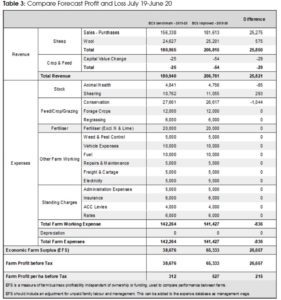Tom Ward
What is your biggest driver of profit in hill country? I would suggest it’s lambing percentage. If you want to improve financial returns from your breeding flock, and are unsure whether it’s worth the effort, you might consider the following FARMAX comparison.
Body condition score (BCS) and scanning percentage
Ewes will increase in liveweight if fed surplus to their needs, ie if stocking rate is reduced, additional feed introduced, or the season is exceptional. It takes 36kg of good quality dry matter to gain 6kg liveweight, ie an extra 240g drymatter per day, above maintenance, between weaning and the start of mating. Conversely it takes half that amount of feed to avoid losing the same liveweight. In most situations it is better to wean at a favourable BCS and maintain it, than plan to regain lost condition.
Maintaining BCS at greater than 3 in winter
Maintaining this minimum 3.0 BCS during winter is very profitable. The science and farmer experience tells us maintaining ewes at BCS 3.0 or better (ie none below 3.0), compared to allowing BCS to decline to 2.5, could typically have the following benefits:
- Increased lamb survival 5%
- Increased lamb growth rate 30g/day
- Increased lamb birth weight 1kg
- Increased ewe survival 1%
 On this basis we could do the following basic gross margin calculation. See Table 1.
On this basis we could do the following basic gross margin calculation. See Table 1.
The calculation is worked to a return per kg drymatter so the margin from putting additional feed into breeding ewes in winter can be compared to other potential uses for the feed; such as wintering trade lambs, wintering steers, bulls or weaner stags, or wintering dairy cows.
Note above, there is no allowance for the cost of the additional feed, nor an allowance for cost of capital which will vary between livestock enterprises, nor for risk. Other enterprises may need additional infrastructure or labour or be more damaging to soils.

Whole farm budget
An accurate picture has been established for the use of additional feed during one part of the year, a whole farm budget should be prepared to show the overall benefit to the farm business.
In this case the higher scanning percentage is combined with the higher lamb survival, lamb birthweight and growth rate.
Scenario one is the benchmark, or “current plan”, where 63kg LW ewes are producing 162% scanning, and 135 % weaning. Scenario two reflects increasing ewe liveweight at the start of mating to 69kg (effectively increasing BCS by 0.5), which increases scanning to 178%. In addition, if BCS is maintained, losses from scanning to lambing could be reduced – in this scenario from 15% to 13% – and losses from tailing to weaning reduced from 2% to 1%, delivering a 153% weaning result.
In my scenarios, stock numbers and grass growth are maintained, and therefore utilisation of pasture increased. Note that increasing BCS consumes more feed, about 190kg DM/ha, and that works within this scenario. The feed efficiency is improved, increasing from 31:1 to 27:1.
There is a substantial improvement in profitability, approximately $200/effective hectare.

Other influences on lamb production:
1. Rearing orphaned or triplet lambs using an automatic calf feeder.
2. Consider selling lambs store if feed tight to maintain ewe condition. This practice also avoids a drop in the lamb schedule and deterioration in feed quality.
3. Wintering some stock off.
4. Grow young stock out well – improves lifetime performance and gives opportunity to mate ewe lambs if feed available.
5. Monitor expected spring grass cover at planned start of lambing. A minimum of 1500kg DM/ha average farm cover should be available.
6. Consider your planned start of lambing (PSL). This should put increased demand from lambing ewes in line with increasing growth.




